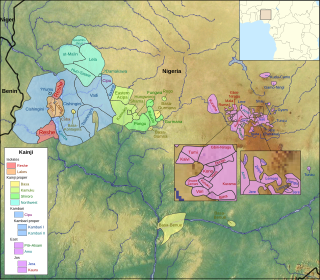Related Research Articles
Pongu (Pangu), or Rin, is a Kainji language spoken in Nigeria. There are about 20,000 speakers. Their main centre is in Pangu Gari town of Niger State, about 20 kilometres southeast of Tegina. In Niger state, Rafi local government Kagara

The Kainji languages are a group of about 60 related languages spoken in west-central Nigeria. They form part of the Central Nigerian (Platoid) branch of Benue–Congo.
u̠t-Ma'in or Fakai is a Northwest Kainji dialect continuum spoken by 36,000 people in Nigeria. There are numerous rather divergent dialects:
The East Kainji languages are spoken in a compact area of the Jos Plateau in Nigeria, near Jos. There are more than 20 of them, most of which are poorly studied.
The Kambari or Kamberi languages) are a cluster of Kainji languages spoken in northwestern Nigeria.
The Shiroro languages, also known as the Pongu languages, form a branch of the Kainji languages of Nigeria. They are spoken near Shiroro Lake.
The Kamuku languages are a branch of the Kainji languages spoken by the Kamuku people of Niger State, western Nigeria, mostly in Mariga and Rafi LGAs.
Lela or C'lela (Clela) is a Kainji language of Nigeria. It is known as Chilela in Hausa, and it is also known as Dakarkari, because it is spoken by the Dakarkari people
Reshe is the most divergent of the Kainji languages of Nigeria. It is spoken on the northern and southern sides of Kainji Lake. It is spoken in Yauri LGA, Kebbi State, and in Borgu LGA, Niger State.
Bauchi is a cluster of Kainji languages spoken in Rafi, Nigeria LGA, Niger State, Nigeria.
The Kimba languages are a group of Kainji languages of Nigeria spoken by the Kambari people. The languages are Kimba (Tsikimba), Gaushi (Agaushi), and Wenci (Ngwunci).
Lopa consists of a pair of minor Kainji languages of Nigeria. The Lopa people neighbouring the Busa language have shifted to that language.
Gwamhi-Wuri (Wurə-Gwamhyə-Mba), or Lyase, is a Kainji language of Nigeria. There are three varieties, which have only slight differences. "Lyase-Ne" means 'mother tongue'.
Fungwa, or Ura is a Kainji language in Pandogari, Niger State, Nigeria. The same word is also used for the people; Roger Blench estimated their numbers at no more than 1,000. Farming is the main occupation of the Fungwa while pottery is also an occupation practised by the women. The Fungwa live in the five villages of Gulbe, Gabi Tukurbe, Urenciki, Renga (Ringa) and Utana along the Pandogari–Allawa road in Rafi, Nigeria.
Eastern Acipa is a Kainji language of Nigeria. It is not close to the language of the same name to its west, though speakers of both are ethnic Acipa. It had 5,000 speakers in 1993. Speakers refer to their language as Tusəgəmuku.
Lere is a nearly extinct Kainji dialect cluster of Nigeria. The ethnic population was cited as 16,000 in 2000, of whom only a few speak the language. A wordlist from the Takaya dialect can be found under External links.
Ziriya (Jiriya) and Sheni (Shaini) constitute a Kainji language of Nigeria. They are geographically but perhaps not linguistically distinct.
Zora (Izora), or Cokoba (Cokobanci) in Hausa, is a Kainji language of Nigeria.
The six Northwest Kainji languages, formerly known as Lela, are spoken near Kainji Lake on the Niger River in Nigeria. They are distinguishable from other Kainji languages by the reduction of their noun-class prefixes to single consonants.
Kagare (Kwagere) is a Kainji language of Nigeria belonging to the Kamuku language complex. There is partial intelligibility with Cinda, Regi and Səgəmuk (Zubazuba). Kagare is reported by Blench, but is not in Ethnologue or Glottolog.
References
- ↑ Blench, Roger (2012). "The Kainji languages of northwestern and central Nigeria" (PDF). Cambridge: Kay Williamson Educational Foundation.